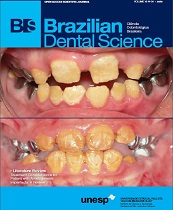The influence of single-dose dexamethasone on masseter and temporal muscles after impacted lower third molar extraction. Pilot study through electromyography evaluation
DOI:
https://doi.org/10.14295/bds.2013.v16i4.933Abstract
This study aimed to evaluate the influence ofdexamethasone (Decadron®) administered aspreoperative single dose (8 mg) on the electricalactivity of the masticatory muscles, superficialmasseter and anterior temporal, through electromyographic analysis after lower third molarextraction. Twenty patients who required surgicaltreatment for extraction of these teeth were selected,treated and evaluated. Patients were randomlyassigned to one of the following groups: experimentalgroup that received a single dose of dexamethasone8 mg 1 h before the procedure, or control groupthat underwent extraction without the use ofmedication. Ag/AgCl electrodes were used to recordthe electrical muscle activity before the procedure,after anesthesia, after root section, immediatepostoperative and 7, 15 and 30 days postoperatively.EMG data collected were analyzed by analysis ofvariance and Tukey’s test with a significance level of5% for intra and intergroup comparisons. The resultsshowed no statistically significant differences in thecomparisons within and between groups (p > 0.05).Based on these findings, it can be concluded that thethird molar extraction and the use of dexamethasoneas a preoperative single dose may not interfere in themuscle electrical activity.
Keywords
Anti-inflammatory drug; Tooth Avulsion; Dental extraction; Electromyography; Masticatory muscles.
Downloads
Downloads
Published
How to Cite
Issue
Section
License
Brazilian Dental Science uses the Creative Commons (CC-BY 4.0) license, thus preserving the integrity of articles in an open access environment. The journal allows the author to retain publishing rights without restrictions.
=================




























